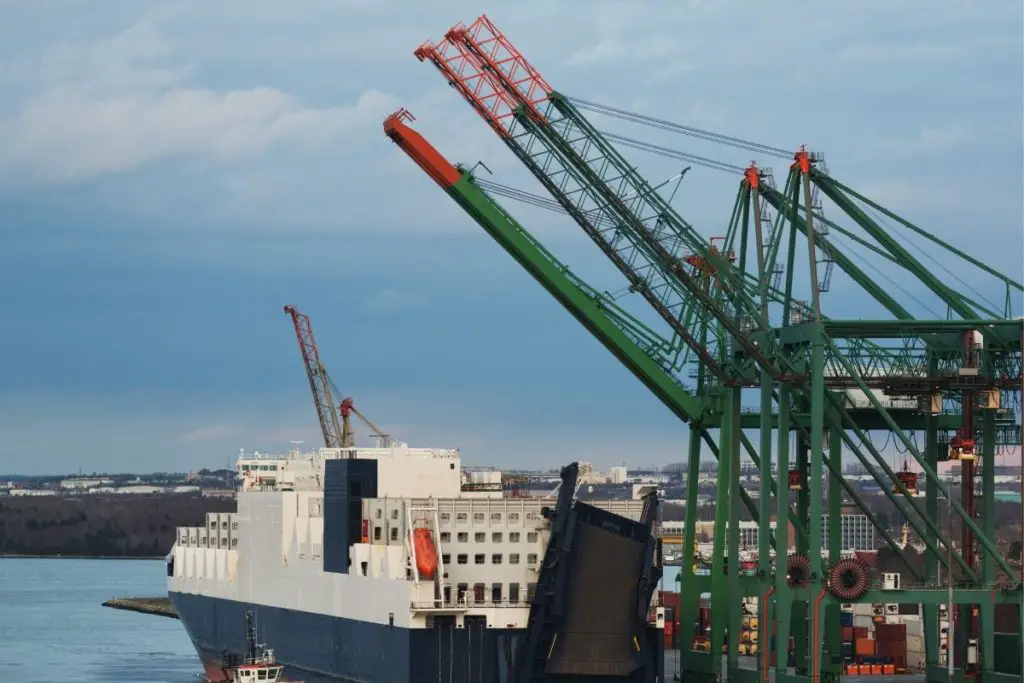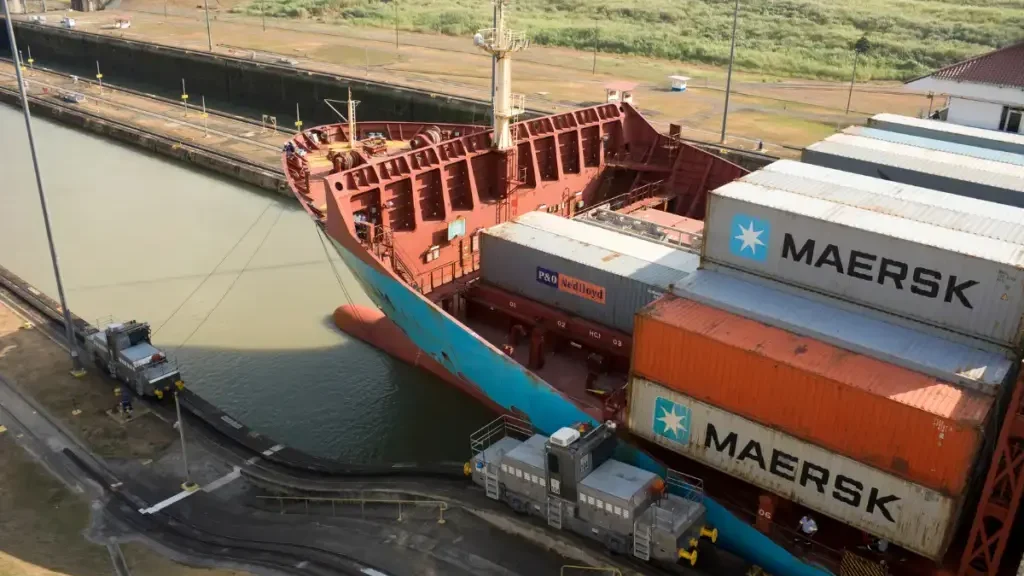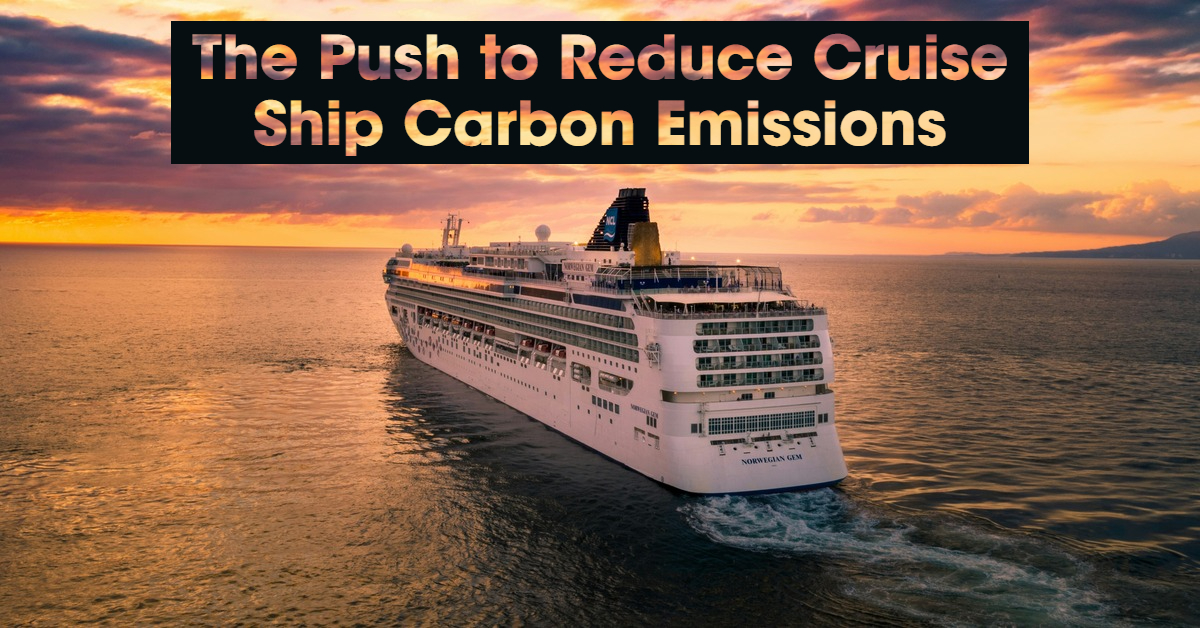Cargo ships, also known as merchant ships, play an essential role in the global economy, efficiently moving large volumes of goods across oceans.
The complexity in understanding a cargo ship’s weight lies in the variance of types and sizes, which in turn affects their capacity and design.
Typical Dimensions and Design
Modern cargo ships are marvels of engineering, designed to carry thousands of containers across the world’s oceans. The dimensions of a cargo ship—its length, width, and draft—dictate its total carrying capacity, which is often measured in Twenty-foot Equivalent Units (TEUs) for container ships.
Large cargo ships may measure approximately 1,400 feet in length and 200 feet in width, with their design optimized for stability, cargo capacity, and fuel efficiency. The deadweight tonnage (DWT) is a crucial indicator of a ship’s weight, encompassing the total weight of the cargo, fuel, fresh water, crew, and passengers.
How Much Does A Cargo Ship Weigh?
When assessing a cargo ship’s weight, it is essential to understand that different measurements such as displacement, deadweight tonnage, and lightship weight are used to express various aspects of a ship’s weight.
What is Displacement?
Displacement refers to the total weight of the water a ship displaces when it is floating. This measurement is equivalent to the actual weight of the ship, including its cargo, fuel, and onboard supplies. For example, a massive cargo ship that is 1,400 feet in length may displace up to 220,000 tons
The most common method to determine the actual weight of a cargo ship is by performing a draft survey. This involves reading the ship’s draft, which is the depth of the ship below the waterline, and calculating the displacement. The displacement, or the volume of water the ship displaces, is then used to estimate the total weight of the ship and its cargo.
What is Deadweight Tonnage?
Deadweight Tonnage (DWT) is the weight of everything a ship can safely carry, including cargo, fuel, crew, and provisions, minus the ship’s own weight. It is a critical measurement used to describe the carrying capacity of the vessel.
Deadweight is often measured in metric tonnes (1,000 kg). As an illustration, some large cargo ships can have a deadweight of over 200,000 tonnes and are capable of handling up to 23,756 TEU (Twenty-Foot Equivalent Units).
What is Lightship Weight?
The lightship weight, or lightweight, indicates the weight of the ship itself without any cargo, fuel, ballast water, stores, or crew. Essentially, it is the weight of the vessel’s structure and represents the baseline for other measurements.
This particular weight can vary significantly depending on the ship’s size and construction materials but is typically measured in tons.
Cargo Ship Capacity
Cargo ship capacity is a critical aspect that encompasses not only the sheer volume of containers a vessel can carry but also the total weight of the cargo, fuel, ballast water, fresh water, personal effects, and ship stores.
Carrying Capacity
Carrying capacity refers to the maximum weight a cargo ship can safely and legally transport. It’s measured in deadweight tonnage (DWT), which includes the weight of cargo, fuel, ballast water, fresh water, personal effects, and ship stores the ship is carrying.
Modern cargo ships come in various sizes, with a deadweight average of around 100,000 tons, for instance. On the upper end, vessels like the ultra-large container ships can have a carrying capacity that averages above 200,000 tons.
Container Capacity
The container capacity of a cargo ship is typically measured in twenty-foot equivalent units (TEUs) and forty-foot equivalent unit (FEUs). For example, a large vessel may transport up to 23,756 TEUs. This translates to thousands of individual containers on a single journey.
These containers can hold a variety of goods, ranging from bulk cargo to personal effects, facilitating global trade efficiency. The efficiency of packing and the type of containers used, such as the standard TEU or the larger FEU, can influence a ship’s actual capacity in a given voyage.
Regulations and Categories
In maritime transport, cargo ships are classified and regulated based on size and weight to ensure safety, efficiency, and environmental protection. These regulations also dictate where a ship can travel and the amount of cargo it can carry.
Size Categories
Cargo ships are divided into several size categories:
- Feeder Ships: Generally the smallest, these vessels are designed to carry goods to and from large ports to smaller ones. Feeder ships typically weigh in the range of a few thousand tonnes.
- General Cargo Vessels: Serve a wide range of functions and vary in size, but are not built to accommodate the massive containers that larger ships can.
- New Panamax: Created following the expansion of the Panama Canal, these ships have a maximum weight limit of 120,000 deadweight tonnage (DWT) and dimensions of up to 366 meters in length and 49 meters in width.
Each size category adheres to a set of standards that defines its capabilities and limitations.
Shipping Industry Standards
The shipping industry operates on a standard set of rules known as charter party agreements. These are contracts that stipulate all the terms, conditions, and definitions regarding the rental of a vessel and its carrying capacity.
The tonnes of cargo that can safely be loaded are strictly regulated to prevent overloading. Sizes of cargo ships, such as New Panamax, are also determinants of what routes they may navigate and what ports can accommodate them.
These industry standards are essential for the harmonious operation of global trade, ensuring that each category of ship optimally performs its intended role.
Largest Cargo Ships
The realm of maritime transport is dominated by a class of vessels known as Ultra Large Container Vessels (ULCVs), exemplifying the pinnacle of cargo ship dimensions. These leviathans boast impressive metrics in both weight and carrying capacity. For instance, a notable ULCV, the MSC’s Irina-class, has been recorded to have a capacity of 24,346 TEU.
Cargo ships, especially those classified as the largest, can have an average deadweight tonnage in the vicinity of 100,000 tons. Some are even more substantial, with certain cargo ships tipping the scales at over 200,000 tons.
ULCVs are ranked not only by their deadweight tonnage but also by their container capacity, measured in Twenty-foot Equivalent Units (TEUs). Modern cargo ships have continued to push the boundaries of these measurements.
| Classification | Average TEU Capacity |
|---|---|
| Ultra Large Container Vessel | 10,000 – 21,000 TEUs |
| Irina-class | Up to 24,346 TEUs |
They represent the upper echelon of cargo ships, designed to ferry massive volumes of goods across oceans. Such substantial weight and capacity are made possible through advancements in naval architecture and marine engineering.
Cargo Ship Sizes by Tonnage
Varying vessel sizes already in existence are nothing to joke about.
All cargo ships operating in oceanic waters are designed to overcome geographical barriers, adapt to certain routes, or even to optimize the transport of particular goods.
However, size is used to determine which commercial route to take, or which ports they can be docked.
But before we discuss how much cargo ships weigh, we’d like to introduce you to the different-sized cargo ships starting with the largest and ending with the smallest.
Ultra Large Container Vessel (ULCV/VLCC/ULCC)
The ship abbreviations stand for Very Large Crude Carriers and Ultra Large Crude Carriers and are more commonly used as ship name prefixes.
These vessels are impressively large container and oil tankers capable of transporting between 150,000-320,000 tons and 320,000-550,000 tons of cargo respectively.
Capesize Vessels
Capesize vessels are used to signify those vessels that cannot pass through the canals of Panama and Suez.
These bulk carriers can transport between 80,000 and 175,000 tons, however, their load carrying extends simply to ores and minerals. Overall, they are quite rare, as are the ports with the space to receive them.
Suezmax
The Suezmax are medium-sized vessels with a capacity of between 120,000 and 200,000 tons. In this case, these vessels aren’t limited by their length or width and only need to conform to a draft of 20 meters.
Panamax
These ships can easily pass through the Panama Canal. The name Panamax applies to oil tankers and cargo ships – both with a capacity of 50,000 to 80,000 tons.
Aframax
It derives its name from a standardized tanker rate system called AFRA (Average Freight Rate Assessment). These vessels are medium-sized tankers that can load between 80,000 and 120,000 tons, making them ideal for short- and medium-distance oil trade.
Handy/Handymax
The Handymax are smaller boats traditionally used for dry cargo and at least 60,000 tons. A Handymax is normally 150-200 meters in length and remains one of the most common types of cargo ships.
As a result, these ships can enter any port without issue.
All of the above vessels have their own significance, usually relating to their allocated oceanic domains.
How Much Can The Largest Cargo Ships Hold?

The largest cargo ships actively operating today are commonly known as Ultra Large Container Ships (ULCV). They are extremely fuel-efficient and are far more environmentally friendly than other variations.
These mega vessels are 23-container widths across and can stack 10 containers high on the top deck, and 8 containers high below the deck.
They have 24 bays and are measured in 18,000-21,000 20-foot equivalents or TEUs. The ULCV can carry between 18,000-21,000 containers or up to 165,000 tons.
How Much Bigger Can Container Ships Get?
Container ships could get as big as 30,000 TEUs in the near future, but shipping ports and waterways will have to be adjusted to accommodate these monstrous vessels, which will take many years.
As a result, larger cargo ships will need to be constructed to withstand a higher volume of weight. Infrastructure, from bridges to waterways to adjoining properties will all need to be adjusted accordingly.
Modern Day Cargo Ships
There are many cargo ships in operation today, all at various weights and sizes. Container ships have become the backbone of commercial freight transport, and play a vital role in the maritime industry.
As of today, almost all non-bulk cargo worldwide is transported by these ships!
We have listed some of the largest cargo vessels in recent history for you to take a look at, noting their measurements, stowage capacity, and their tonnage.
MSC Jade
The smallest cargo ship on our list belongs to the fleet of the Mediterranean Shipping Company. The MSC Jade measures 398.40 meters by 59.00 meters wide, and 30.30 meters high.
The MSC Jade also has an approximate deadweight tonnage of 199,000 tons and a storage capacity of around 19,224 TEUs.
MSC Leanne
MSC Leanne is one of the newest ships in the cargo fleet of the Mediterranean Shipping Company. This ship can carry 19,462 TEUs and has a deadweight tonnage of 172,785. The ship measures 399.99 meters by 58.80 meters, and 30.20 meters high.
MSC Rifaya
A Liberian ship, this MSC ship was called the MSC Rifaya. It is 399.99 meters long with a width of 58.80 meters, and a draft of 23.31 meters. This vessel has a carrying capacity of 19,462 TEUs, and its deadweight tonnage is 196,000 tons.
MSC Mirjam
MSC Mirjam is owned and operated by the Mediterranean Shipping Company, and is another Pegasus-class container vessel.
It is 399.99 meters long and 58.80 meters wide, making it a very impressive sight. The MSC Mirjam also has a draught of 23.31 meters and a carrying capacity of approximately 19,462 TEUs.
MSC Eloane
The MSC Eloane is another cargo vessel operating today. This ship is a Pegasus-class container vessel that has a length of 399.99 meters, a breadth of 58.80 meters, and a draft of 31.31 meters. It also has a carrying capacity of 19,462 TEUs and an impressive deadweight of 201,869 tons!
MSC Ingy
The MSC Ingy is one of the largest cargo ships serving under the flag of Liberia. Its dimensions are as follows: 399.99 meters in length and 58.80 meters in width, with a draft of 23.31 meters. Its maximum carrying capacity is 19,462 TEUs. If that wasn’t enough, it has a deadweight tonnage of 210,869!
Ever Golden
This cargo ship was built by Imabari Shipbuilding Company Limited shipyard and sails under the flag of Panama. Built in 2018, it is 400 meters in length with a beam of 58.8 meters.
The ship has a gross tonnage of 21, 7612, a deadweight of 199,692, and a container capacity of 20,000 TEU. One thing Ever Golden lacks is the ability to serve with very high speed, with a maximum recorded speed of 11.4 knots.
MSC Diana
MSC Diana is registered as a Liberian ship. It is owned and operated by the Mediterranean Shipping Company, and is a Pegasus-class container ship.
It actually remains one of the largest cargo vessels in the world, boasting 19,462 TEUs carrying capacity and a weight of 197,708 tons.
The overall length of this ship is 399.99 m. Its beam has a width of 58.80 meters, and its draft is 30.20 meters.
MOL Triumph
The MOL Triumph is another large container ship. It once held the record for the biggest and heaviest cargo ship in the world, up until the Madrid Maersk overtook it.
This ship is 400 meters long, 58.8 meters wide, and 32 meters high. It was also the first 20,000 TEU ship in a fleet of six ships in MOL’s dockyard.
Madrid Maersk

Madrid Maersk was built for the Maersk Line. It is the first of 11 second-generation Maersk Triple E-class container ships. During its launch in 2017, it became the second 20,000 TEU-class container ship ever (with 20,568 TEU).
With a deadweight Tonnage of 192,672MT, Madrid Maersk measures 399 meters in length and 58.8 meters in breadth.
COSCO Shipping Universe
Registered and sailing under the flag of Hong Kong, this relatively new build is the largest cargo ship in China with a carrying capacity of 21,237 TEU.
It’s also quite impressive with a length of 400 meters, a width of 58.6 meters, and a maximum sailing speed of 22 knots.
With a deadweight of 199,000 MT, COSCO Shipping Universe is a flagship vessel of the 21st Century Maritime Silk Road.
OOCL Hong Kong
This vessel was built and manufactured by the Orient Overseas Container Lines (OOCL). It is one of the largest cargo ships ever constructed with a length of 399.87 meters.
It is actually one of the largest vessels on this list and can carry a large amount of 21,413 TEU containers.
Furthermore, this ship has a deadweight of 197,317 tons, a beam of 58.8 meters, and a depth of 32.5 meters. Because of its weight and size, the OOCL Hong Kong is considered to be an Ultra Large Container Vessel.
- Sustainable and Luxurious: Discovering Split’s Yachting Paradise – April 26, 2024
- MarineTraffic vs VesselFinder: Which Is Better Vessel Tracking Service? – February 14, 2024
- Port Costs: A Comprehensive Guide to Port Dues and Fees for Cargo Ships – February 12, 2024





Leave a Reply